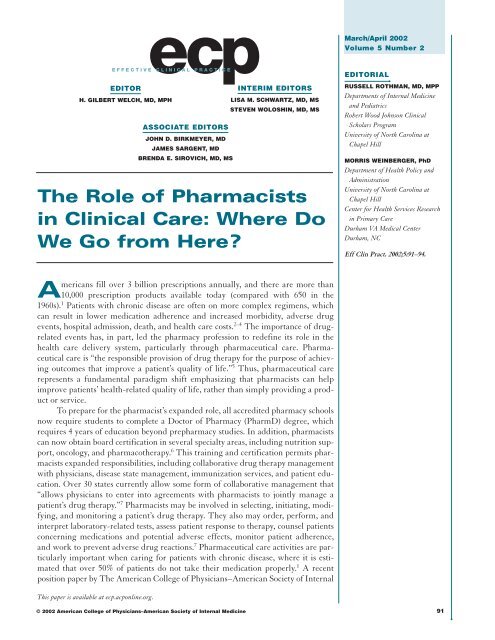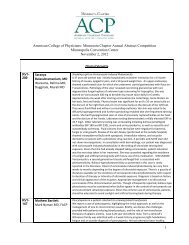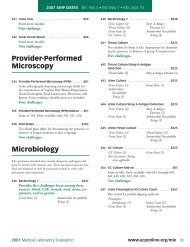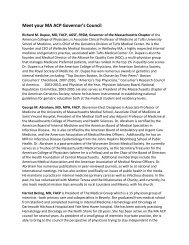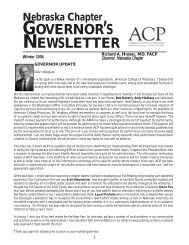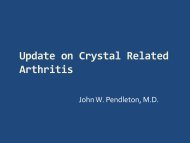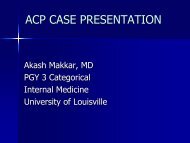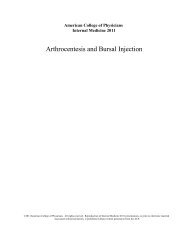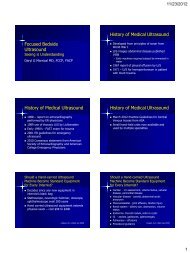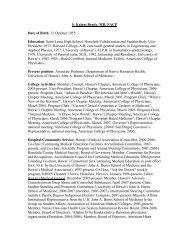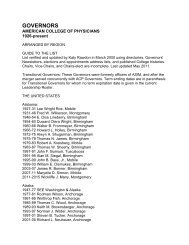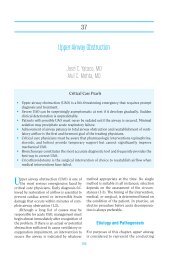The Role of Pharmacists in Clinical Care: Where Do We Go from ...
The Role of Pharmacists in Clinical Care: Where Do We Go from ...
The Role of Pharmacists in Clinical Care: Where Do We Go from ...
Create successful ePaper yourself
Turn your PDF publications into a flip-book with our unique Google optimized e-Paper software.
March/April 2002<br />
Volume 5 Number 2<br />
EFFECTIVE CLINICAL PRACTICE<br />
EDITOR<br />
H. GILBERT WELCH, MD, MPH<br />
ASSOCIATE EDITORS<br />
JOHN D. BIRKMEYER, MD<br />
JAMES SARGENT, MD<br />
BRENDA E. SIROVICH, MD, MS<br />
INTERIM EDITORS<br />
LISA M. SCHWARTZ, MD, MS<br />
STEVEN WOLOSHIN, MD, MS<br />
<strong>The</strong> <strong>Role</strong> <strong>of</strong> <strong>Pharmacists</strong><br />
<strong>in</strong> Cl<strong>in</strong>ical <strong>Care</strong>: <strong>Where</strong> <strong>Do</strong><br />
<strong>We</strong> <strong>Go</strong> <strong>from</strong> Here?<br />
EDITORIAL<br />
•<br />
RUSSELL ROTHMAN, MD, MPP<br />
Departments <strong>of</strong> Internal Medic<strong>in</strong>e<br />
and Pediatrics<br />
Robert Wood Johnson Cl<strong>in</strong>ical<br />
Scholars Program<br />
University <strong>of</strong> North Carol<strong>in</strong>a at<br />
Chapel Hill<br />
MORRIS WEINBERGER, PhD<br />
Department <strong>of</strong> Health Policy and<br />
Adm<strong>in</strong>istration<br />
University <strong>of</strong> North Carol<strong>in</strong>a at<br />
Chapel Hill<br />
Center for Health Services Research<br />
<strong>in</strong> Primary <strong>Care</strong><br />
Durham VA Medical Center<br />
Durham, NC<br />
Eff Cl<strong>in</strong> Pract. 2002;5:91–94.<br />
Americans fill over 3 billion prescriptions annually, and there are more than<br />
10,000 prescription products available today (compared with 650 <strong>in</strong> the<br />
1960s). 1 Patients with chronic disease are <strong>of</strong>ten on more complex regimens, which<br />
can result <strong>in</strong> lower medication adherence and <strong>in</strong>creased morbidity, adverse drug<br />
events, hospital admission, death, and health care costs. 2–4 <strong>The</strong> importance <strong>of</strong> drugrelated<br />
events has, <strong>in</strong> part, led the pharmacy pr<strong>of</strong>ession to redef<strong>in</strong>e its role <strong>in</strong> the<br />
health care delivery system, particularly through pharmaceutical care. Pharmaceutical<br />
care is “the responsible provision <strong>of</strong> drug therapy for the purpose <strong>of</strong> achiev<strong>in</strong>g<br />
outcomes that improve a patient’s quality <strong>of</strong> life.” 5 Thus, pharmaceutical care<br />
represents a fundamental paradigm shift emphasiz<strong>in</strong>g that pharmacists can help<br />
improve patients’ health-related quality <strong>of</strong> life, rather than simply provid<strong>in</strong>g a product<br />
or service.<br />
To prepare for the pharmacist’s expanded role, all accredited pharmacy schools<br />
now require students to complete a <strong>Do</strong>ctor <strong>of</strong> Pharmacy (PharmD) degree, which<br />
requires 4 years <strong>of</strong> education beyond prepharmacy studies. In addition, pharmacists<br />
can now obta<strong>in</strong> board certification <strong>in</strong> several specialty areas, <strong>in</strong>clud<strong>in</strong>g nutrition support,<br />
oncology, and pharmacotherapy. 6 This tra<strong>in</strong><strong>in</strong>g and certification permits pharmacists<br />
expanded responsibilities, <strong>in</strong>clud<strong>in</strong>g collaborative drug therapy management<br />
with physicians, disease state management, immunization services, and patient education.<br />
Over 30 states currently allow some form <strong>of</strong> collaborative management that<br />
“allows physicians to enter <strong>in</strong>to agreements with pharmacists to jo<strong>in</strong>tly manage a<br />
patient’s drug therapy.” 7 <strong>Pharmacists</strong> may be <strong>in</strong>volved <strong>in</strong> select<strong>in</strong>g, <strong>in</strong>itiat<strong>in</strong>g, modify<strong>in</strong>g,<br />
and monitor<strong>in</strong>g a patient’s drug therapy. <strong>The</strong>y also may order, perform, and<br />
<strong>in</strong>terpret laboratory-related tests, assess patient response to therapy, counsel patients<br />
concern<strong>in</strong>g medications and potential adverse effects, monitor patient adherence,<br />
and work to prevent adverse drug reactions. 7 Pharmaceutical care activities are particularly<br />
important when car<strong>in</strong>g for patients with chronic disease, where it is estimated<br />
that over 50% <strong>of</strong> patients do not take their medication properly. 1 A recent<br />
position paper by <strong>The</strong> American College <strong>of</strong> Physicians–American Society <strong>of</strong> Internal<br />
This paper is available at ecp.acponl<strong>in</strong>e.org.<br />
© 2002 American College <strong>of</strong> Physicians–American Society <strong>of</strong> Internal Medic<strong>in</strong>e<br />
91<br />
•
TABLE 1<br />
ACP Positions on Pharmacist Scope <strong>of</strong> Practice and Potential for Research<br />
ACP–ASIM POSITION*<br />
RATIONALE*<br />
FURTHER RESEARCH TO EXAMINE<br />
Supports research <strong>in</strong>to<br />
the effects <strong>of</strong> pharmacy<br />
automation and the move<br />
to the PharmD degree<br />
Supports physician-directed<br />
collaborative practice agreements<br />
between the pharmacist<br />
and the physician, limited<br />
to pharmacist <strong>in</strong>volvement<br />
<strong>in</strong> patient education<br />
and hospital rounds<br />
Opposed <strong>in</strong>dependent<br />
pharmacist prescription<br />
privileges and <strong>in</strong>itiation <strong>of</strong><br />
drug therapy<br />
Supports the use <strong>of</strong> the<br />
pharmacist as immunization<br />
<strong>in</strong>formation source. . .immunizer,<br />
as appropriate<br />
Reiterates its support <strong>of</strong><br />
its 1990 therapeutic<br />
substitution position<br />
Store-based pharmacists currently spend<br />
over 60% <strong>of</strong> their time process<strong>in</strong>g and<br />
dispens<strong>in</strong>g orders; automation and<br />
pharmacy technicians will free up this<br />
time<br />
PharmD degree has expanded cl<strong>in</strong>ical<br />
tra<strong>in</strong><strong>in</strong>g<br />
Pharmacist <strong>in</strong>terventions <strong>in</strong> the hospital<br />
sett<strong>in</strong>g have been successful <strong>in</strong> improv<strong>in</strong>g<br />
cl<strong>in</strong>ical outcomes, reduc<strong>in</strong>g cost,<br />
and reduc<strong>in</strong>g adverse events<br />
Question if pharmacist tra<strong>in</strong><strong>in</strong>g is sufficient<br />
for <strong>in</strong>dependent <strong>in</strong>itiation <strong>of</strong> medications<br />
No evidence to support this activity<br />
30 states already allow pharmacists to<br />
give immunizations<br />
Pharmacies are a readily accessible site<br />
and can <strong>in</strong>crease immunization rates<br />
Supports previous position<br />
In accordance with American College <strong>of</strong><br />
Cl<strong>in</strong>ical Pharmacy<br />
Expand<strong>in</strong>g roles <strong>of</strong> community<br />
pharmacist<br />
Level <strong>of</strong> autonomy for community<br />
pharmacists<br />
Impact <strong>of</strong> PharmD tra<strong>in</strong><strong>in</strong>g<br />
Organizational structures to enhance<br />
physician–pharmacist communication<br />
Technologies (e.g., Internet, automated<br />
phone systems, home monitor<strong>in</strong>g<br />
equipment) that can improve this<br />
communication<br />
Pharmacist role <strong>in</strong> community-based,<br />
disease state management <strong>in</strong> the<br />
outpatient sett<strong>in</strong>g<br />
Practical programs and protocols that are<br />
acceptable to patients, pharmacists, and<br />
physicians<br />
Pharmacist prescrib<strong>in</strong>g under close<br />
guidel<strong>in</strong>es and supervision<br />
Effect <strong>of</strong> these programs on improv<strong>in</strong>g<br />
patient outcomes and cost-effectiveness<br />
Effect <strong>of</strong> these actions on improv<strong>in</strong>g<br />
patient outcomes and cost-effectiveness<br />
*Adapted <strong>from</strong> P<strong>in</strong>cus and colleagues. 6 ACP–ASIM = American College <strong>of</strong> Physicians–American Society <strong>of</strong> Internal Medic<strong>in</strong>e.<br />
Medic<strong>in</strong>e (ACP–ASIM) 6 recognizes the <strong>in</strong>creas<strong>in</strong>g scope<br />
<strong>of</strong> pharmacists and outl<strong>in</strong>es “how the medical pr<strong>of</strong>ession<br />
can work with pharmacists to enhance patient safety<br />
and quality <strong>of</strong> care.” Table 1 describes these positions,<br />
their rationale, and areas for future research.<br />
Empirical evidence about the benefits <strong>of</strong> pharmaceutical<br />
care has been generally positive, but the strength<br />
<strong>of</strong> the evidence is problematic. Several randomized trials<br />
have shown that cl<strong>in</strong>ical pharmacists can play a key<br />
role <strong>in</strong> disease management models for anticoagulation<br />
treatment, hypertension, hyperlipidemia, asthma, and<br />
other chronic conditions. 8–11 However, several recent literature<br />
reviews suggest that the enthusiastic reports are<br />
<strong>of</strong>ten plagued by serious design flaws, lack <strong>of</strong> controls,<br />
absence <strong>of</strong> appropriate controls, <strong>in</strong>correct analyses (e.g.,<br />
report<strong>in</strong>g with<strong>in</strong>-group rather than between-group<br />
comparisons), small sample sizes, short follow-up periods,<br />
and lack <strong>of</strong> patient outcome data. 12–15 <strong>The</strong>se reviews<br />
suggest that there is evidence support<strong>in</strong>g the effectiveness<br />
<strong>of</strong> pharmaceutical care delivered dur<strong>in</strong>g hospital<br />
admissions, less evidence <strong>in</strong> outpatient sett<strong>in</strong>gs, and no<br />
well-designed studies support<strong>in</strong>g the effectiveness <strong>of</strong><br />
pharmaceutical care <strong>in</strong> retail pharmacies. One recent<br />
review 13 identified 21 studies conducted <strong>in</strong> community<br />
pharmacy sett<strong>in</strong>gs that measured the impact <strong>of</strong> pharmaceutical<br />
services on patient outcomes. <strong>The</strong> authors<br />
found that many <strong>of</strong> these studies had significant<br />
methodologic problems, and none evaluated the impact<br />
<strong>of</strong> pharmaceutical care on economic, cl<strong>in</strong>ical, and<br />
humanistic outcomes. <strong>The</strong> authors recommend that<br />
pharmaceutical services <strong>in</strong> community and ambulatory<br />
care sett<strong>in</strong>gs should be evaluated us<strong>in</strong>g multisite randomized<br />
trials that attend to the forego<strong>in</strong>g issues. 13<br />
In this issue <strong>of</strong> ecp, Fischer and colleagues 16 take<br />
a step toward evaluat<strong>in</strong>g the impact <strong>of</strong> community pharmacists<br />
on patient outcomes. In this nonrandomized but<br />
92<br />
•<br />
Effective Cl<strong>in</strong>ical Practice ■ March/April 2002 Volume 5 Number 2
Physician<br />
FIGURE 1. Model for community-based<br />
pharmaceutical<br />
care.<br />
Access to<br />
patient-specific<br />
cl<strong>in</strong>ical data<br />
Tra<strong>in</strong><strong>in</strong>g <strong>in</strong><br />
pharmaceutical<br />
care and disease<br />
state management<br />
Community<br />
pharmacist<br />
Access to cl<strong>in</strong>ical<br />
support and<br />
algorithms for<br />
evidence-based care<br />
Address<br />
organizational<br />
barriers (time,<br />
confidentiality, etc.)<br />
Patient<br />
Outcomes:<br />
cl<strong>in</strong>ical social<br />
economic<br />
controlled trial, pharmacists identified drug therapy<br />
problems <strong>in</strong> 69% <strong>of</strong> the <strong>in</strong>tervention patients and provided<br />
some level <strong>of</strong> <strong>in</strong>tervention for 87% <strong>of</strong> these<br />
patients. This comprehensive drug management <strong>in</strong>tervention<br />
appeared to result <strong>in</strong> a small but significant<br />
<strong>in</strong>crease <strong>in</strong> the number <strong>of</strong> unique medications (1.0 vs.<br />
0.4; P = 0.03) and a trend toward <strong>in</strong>creased cl<strong>in</strong>ic visits<br />
and overall charges. This <strong>in</strong>crease <strong>in</strong> utilization is consistent<br />
with a randomized, controlled trial that evaluated<br />
the impact <strong>of</strong> pharmaceutical care delivered by community<br />
pharmacists to patients with asthma or chronic<br />
lung disease. 17 <strong>The</strong> <strong>in</strong>terpretations <strong>of</strong> these f<strong>in</strong>d<strong>in</strong>gs are<br />
h<strong>in</strong>dered by major research design limitations, most <strong>of</strong><br />
which the <strong>in</strong>vestigators acknowledge. <strong>The</strong> nonrandomized<br />
design, comb<strong>in</strong>ed with nonspecific def<strong>in</strong>itions <strong>of</strong><br />
disease conditions and selection bias, make it difficult to<br />
evaluate the true effectiveness <strong>of</strong> the <strong>in</strong>tervention. In<br />
addition, the exact nature <strong>of</strong> the <strong>in</strong>tervention is not well<br />
def<strong>in</strong>ed, and as the <strong>in</strong>vestigators concede, it may not<br />
have been potent enough. It is not clear whether the<br />
<strong>in</strong>tervention allowed the pharmacists to make improvements<br />
<strong>in</strong> a proactive rather than a reactive manner.<br />
F<strong>in</strong>ally, one <strong>of</strong> the most important limitations is the<br />
emphasis on utilization <strong>of</strong> services as the primary outcome<br />
without any evaluation <strong>of</strong> patient-centered outcomes,<br />
such as quality <strong>of</strong> care, or cl<strong>in</strong>ical outcomes.<br />
Although the study suggests that patient use <strong>of</strong> services<br />
is <strong>in</strong>creased, we do not know if this improved quality or<br />
outcomes <strong>of</strong> care.<br />
Despite these limitations, this study provides us<br />
with some important research on community-based<br />
pharmaceutical care and po<strong>in</strong>ts to several research questions<br />
that need to be more adequately addressed. For<br />
example, what models <strong>of</strong> pharmaceutical care are the<br />
most successful? What are the specific roles that pharmacists<br />
can perform? What outcomes are improved by<br />
these <strong>in</strong>terventions? What methods should be used to<br />
best evaluate this research?<br />
<strong>The</strong>re has been a fair amount <strong>of</strong> research on the<br />
role <strong>of</strong> pharmacists <strong>in</strong> the <strong>in</strong>patient and selected outpatient<br />
sett<strong>in</strong>gs. However, we believe that well-designed,<br />
randomized, controlled trials <strong>in</strong> retail pharmacies are<br />
critical because that is the venue where patients and<br />
pharmacists most <strong>of</strong>ten <strong>in</strong>teract. A major benefit <strong>of</strong> conduct<strong>in</strong>g<br />
research <strong>in</strong> large retail cha<strong>in</strong>s is that they possess<br />
the capability to rapidly implement effective programs<br />
throughout their stores. In Figure 1, we propose a conceptual<br />
model for the design and evaluation <strong>of</strong> community-based<br />
pharmaceutical care. <strong>The</strong>se <strong>in</strong>novative programs<br />
will need to be evaluated <strong>in</strong> terms <strong>of</strong> patients’<br />
cl<strong>in</strong>ical outcomes (e.g., disease status, health-related<br />
quality <strong>of</strong> life) and cost-effectiveness. Barriers to the<br />
Effective Cl<strong>in</strong>ical Practice ■ March/April 2002 Volume 5 Number 2 93<br />
•
proper design, implementation, and evaluation <strong>of</strong> this<br />
research will be considerable. Interventions will require<br />
partnerships between academic and private enterprise.<br />
Successful <strong>in</strong>terventions will need to be potent enough to<br />
effect change, without plac<strong>in</strong>g too much responsibility on<br />
the pharmacists or be<strong>in</strong>g too cumbersome economically.<br />
Long-term implementation will require the <strong>in</strong>tervention<br />
to be reliably replicated under uncontrolled conditions. 18<br />
In addition, we will need to determ<strong>in</strong>e reimbursement<br />
strategies that allow pharmacists to provide pharmaceutical<br />
care. <strong>We</strong> support <strong>The</strong> Agency for Healthcare<br />
Research and Quality statement that the challenge for<br />
the next generation <strong>of</strong> outcomes and effectiveness<br />
research is the acceleration <strong>of</strong> the process by which f<strong>in</strong>d<strong>in</strong>gs<br />
impact policy and practice. 19 Given patients’ <strong>in</strong>creas<strong>in</strong>gly<br />
complex medication regimens, we believe that<br />
develop<strong>in</strong>g creative ways to <strong>in</strong>crease community-based<br />
pharmacist <strong>in</strong>volvement <strong>in</strong> patient care represents an<br />
important direction for research.<br />
References<br />
1. Today’s Pharmacist...the patient’s partner <strong>in</strong> medication management,<br />
vol 2002: Alliance for Pharmaceutical <strong>Care</strong>, Partners<br />
to Improve Health Outcomes. Available at www.accp.com/<br />
position/paper11.pdf. Accessed February 1, 2001.<br />
2. Cohn JN. <strong>The</strong> management <strong>of</strong> chronic heart failure. N Engl J<br />
Med. 1996;335:490-8.<br />
3. Fonarow GC, Stevenson LW, Walden JA, et al. Impact <strong>of</strong> a<br />
comprehensive heart failure management program on hospital<br />
readmission and functional status <strong>of</strong> patients with advanced<br />
heart failure. J Am Coll Cardiol. 1997;30:725-32.<br />
4. Rich MW. Heart failure disease management: a critical review.<br />
J Card Fail. 1999;5:64-75.<br />
5. Hepler CD, Strand LM. Opportunities and responsibilities <strong>in</strong><br />
pharmaceutical care. Am J Hosp Pharm. 1990;47:533-43.<br />
6. P<strong>in</strong>cus T, Sokka T, Ste<strong>in</strong> CM. Pharmacist scope <strong>of</strong> practice.<br />
Ann Intern Med. 2002;136:79-85.<br />
7. <strong>Pharmacists</strong> f<strong>in</strong>d<strong>in</strong>g solutions through collaboration, vol. 2002:<br />
Alliance for Pharmaceutical <strong>Care</strong>, Partners to Improve Health<br />
Outcomes. Available at www.accp.com/position/paper10.pdf.<br />
Accessed February 1, 2001.<br />
8. Bero LA, Mays NB, Barjesteh K, Bond C. Expand<strong>in</strong>g the roles<br />
<strong>of</strong> outpatient pharmacists: effects on health services utilisation,<br />
costs, and patient outcomes. Cochrane Database Syst Rev<br />
2000;2.<br />
9. Chiquette E, Amato MG, Bussey HI. Comparison <strong>of</strong> an anticoagulation<br />
cl<strong>in</strong>ic with usual medical care: anticoagulation<br />
control, patient outcomes, and health care costs. Arch Intern<br />
Med. 1998;158:1641-7.<br />
10. Mehos BM, Saseen JJ, MacLaughl<strong>in</strong> EJ. Effect <strong>of</strong> pharmacist<br />
<strong>in</strong>tervention and <strong>in</strong>itiation <strong>of</strong> home blood pressure monitor<strong>in</strong>g<br />
<strong>in</strong> patients with uncontrolled hypertension. Pharmacotherapy.<br />
2000;20:1384-9.<br />
11. Bozovich M, Rub<strong>in</strong>o CM, Edmunds J. Effect <strong>of</strong> a cl<strong>in</strong>ical<br />
pharmacist-managed lipid cl<strong>in</strong>ic on achiev<strong>in</strong>g National<br />
Cholesterol Education Program low-density lipoprote<strong>in</strong> goals.<br />
Pharmacotherapy. 2000;20:1375-83.<br />
12. Hatoum HT, Akhras K. 1993 Bibliography: a 32-year literature<br />
review on the value and acceptance <strong>of</strong> ambulatory care<br />
provided by pharmacists. Ann Pharmacother. 1993;27:1106-19.<br />
13. S<strong>in</strong>ghal PK, Raisch DW, Gupchup GV. <strong>The</strong> impact <strong>of</strong> pharmaceutical<br />
services <strong>in</strong> community and ambulatory care sett<strong>in</strong>gs:<br />
evidence and recommendations for future research. Ann<br />
Pharmacother. 1999;33:1336-55.<br />
14. Tett SE, Higg<strong>in</strong>s GM, Armour CL. Impact <strong>of</strong> pharmacist<br />
<strong>in</strong>terventions on medication management by the elderly: a<br />
review <strong>of</strong> the literature. Ann Pharmacother. 1993;27:80-6.<br />
15. Kennie NR, Schuster BG, E<strong>in</strong>arson TR. Critical analysis <strong>of</strong><br />
the pharmaceutical care research literature. Ann Pharmacother.<br />
1998;32:17-26.<br />
16. Fischer LR, DeFor TA, <strong>Go</strong>odmanMJ, et al. Pharmaceutical<br />
care and health care utilization <strong>in</strong> an HMO. Eff Cl<strong>in</strong> Pract.<br />
2002;5:49-57.<br />
17. <strong>We</strong><strong>in</strong>berger M, Murray M, Marrero D, et al. A randomized<br />
trial <strong>of</strong> pharmaceutical care. J Gen Intern Med. 2001;<br />
16(Suppl):181.<br />
18. Campbell M, Fitzpatrick R, Ha<strong>in</strong>es A, et al. Framework for<br />
design and evaluation <strong>of</strong> complex <strong>in</strong>terventions to improve<br />
health. BMJ. 2000;321:694-6.<br />
19. Stryer D, Tunis S, Hubbard H, Clancy C. <strong>The</strong> outcomes <strong>of</strong><br />
outcomes and effectiveness research: impacts and lessons <strong>from</strong><br />
the first decade. Health Serv Res. 2000;35:977-93.<br />
Correspondence<br />
Russell Rothman, MD, MPP, UNC Cl<strong>in</strong>ical Scholars Program,<br />
CB7105, 5034 Old Cl<strong>in</strong>ic Build<strong>in</strong>g, University <strong>of</strong> North Carol<strong>in</strong>a<br />
at Chapel Hill, Chapel Hill, NC 27599; telephone: 919-966-1274;<br />
fax: 919-843-9237; e-mail: rothman@mail.schsr.unc.edu.<br />
94<br />
•<br />
Effective Cl<strong>in</strong>ical Practice ■ March/April 2002 Volume 5 Number 2


